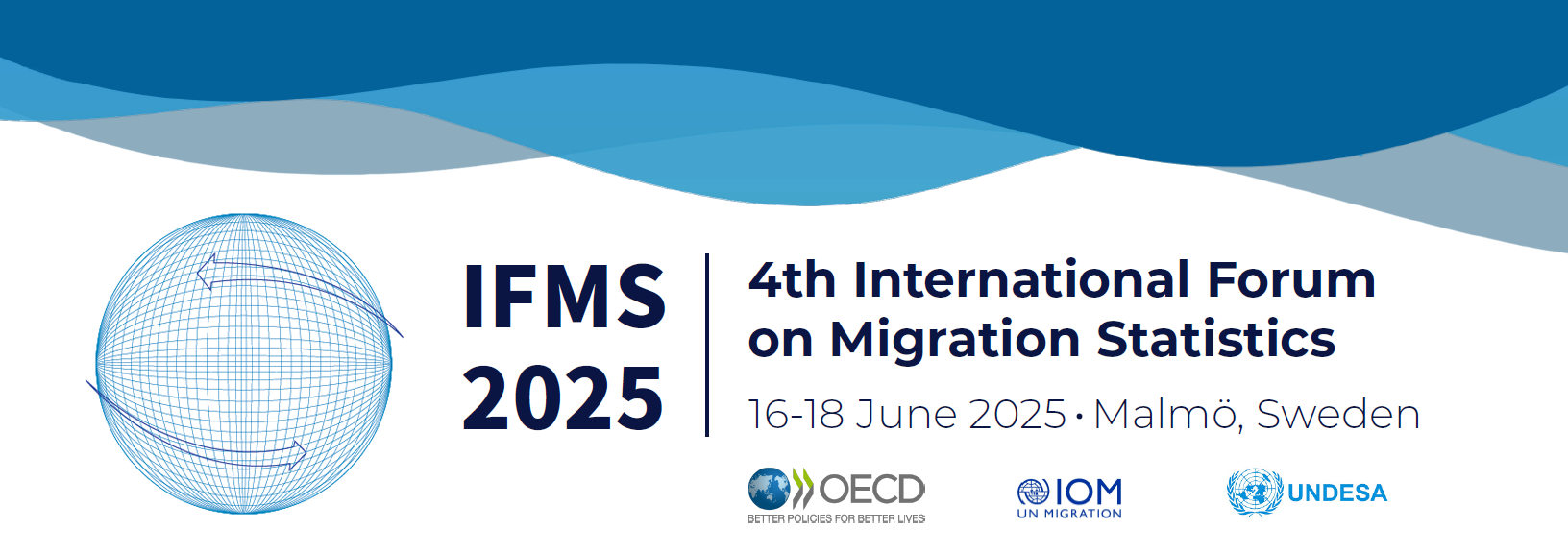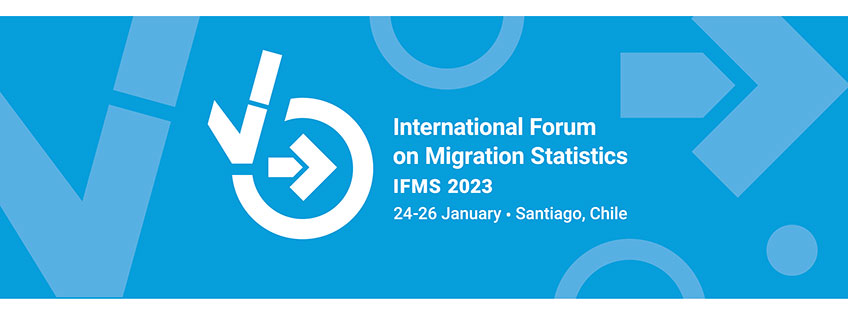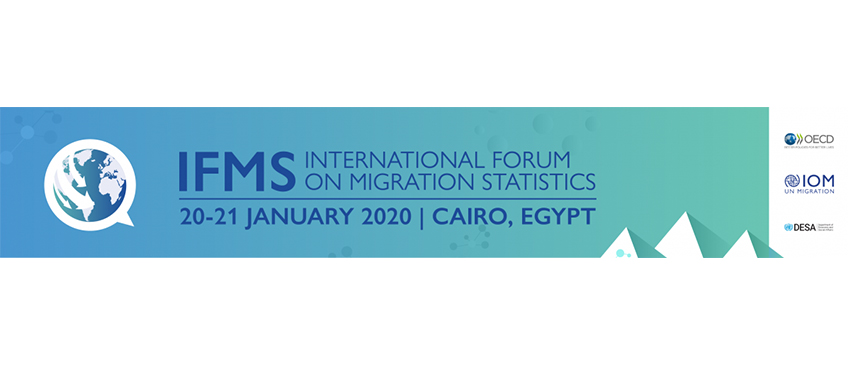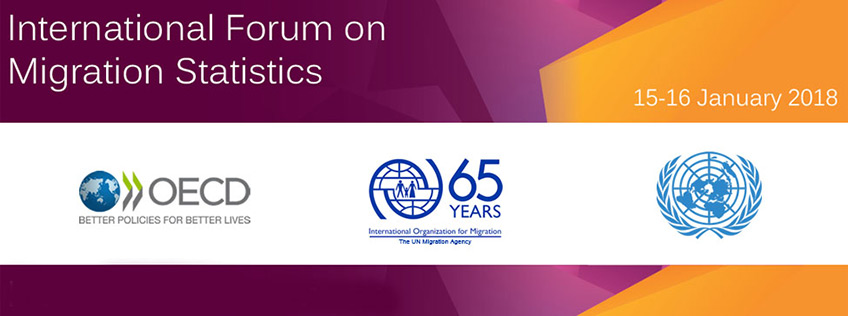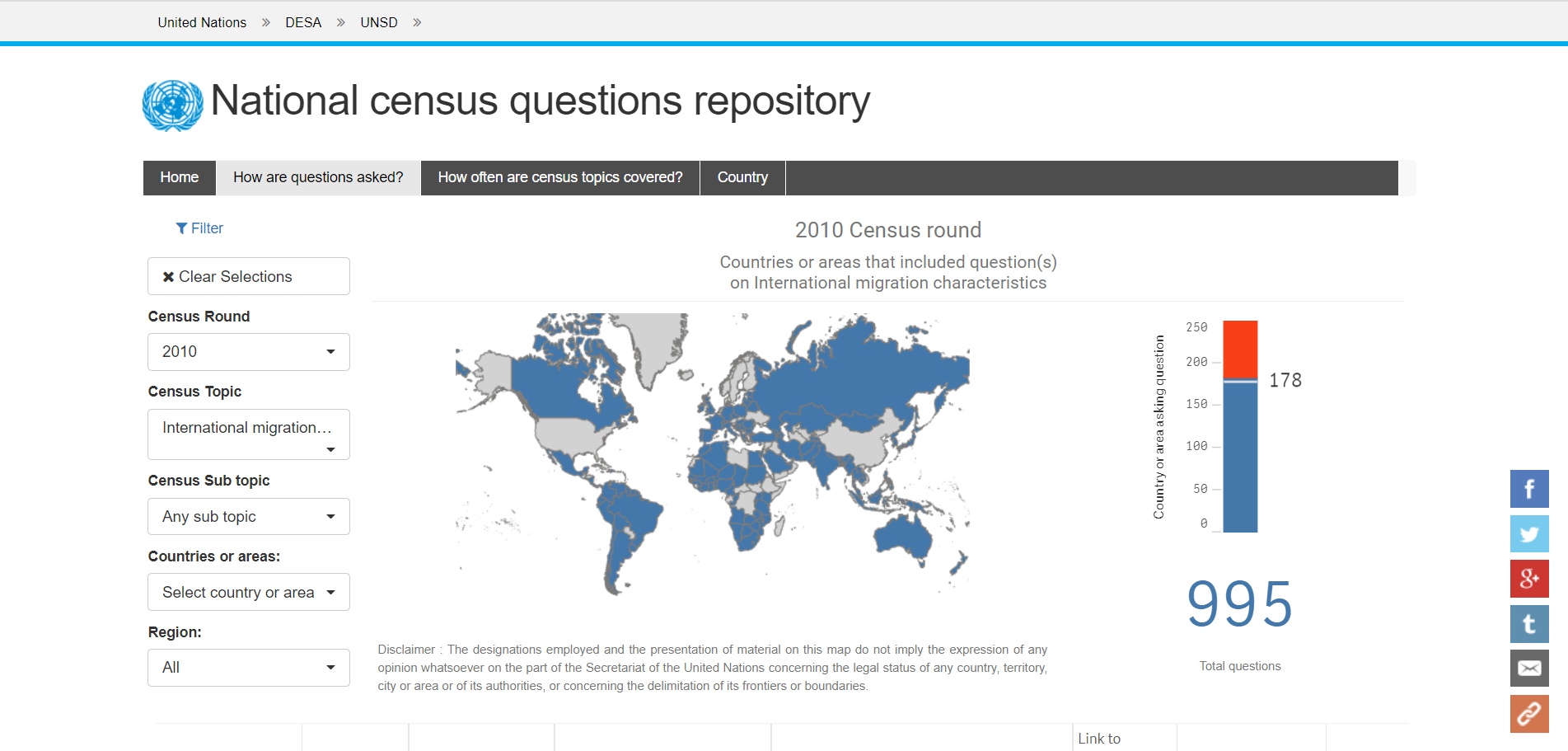Demographic and Social Statistics
International Migration
The United Nations Statistics Division (UNSD)
- Collects and disseminates official national data on international migrant flows and stocks through Demographic Yearbook data collection
- Produces international standards and methods related to international migration statistics
- Assists countries in enhancing their capacity on migration statistics
- Coordinates statistical programmes and activities through the United Nations Expert Group on Migration Statistics
Other UN System entities working on migration statistics
The International Labour Organisation (ILO) collects and compiles international labour migration statistics.
The International Organisation for Migration (IOM) collects and publishes various data including on internal displacement, missing migrants and migration governance, and collects, uses, analyses and publishes primary and secondary data across a wider range of migration topics.
The United Nations High Commissioner for Refugees (UNHCR) collects and compiles data on asylum seekers and refugees more specifically on asylum applications, refugee status determination, recognition rates, refugee populations and movements, demographic characteristics (age and sex) as well as major refugee locations (camps, centers, urban areas, etc.).
The United Nations Population Division prepares estimates of migrant stock for each country using the data provided by the United Nations Statistics Division; undertakes regular studies on national policies on international migration and assesses the impact of international migration on development.
The United Nations Relief and Works Agency for Palestine Refugee (UNRWA) provides statistics about Palestinian refugees, Agency installations, budget and staff for the programme in its areas of operations in Jordan, Lebanon, the Syrian Arab Republic, and the Occupied Palestinian Territory.
Data collection
The United Nations Statistics Division collects data on flows and stock of migrants through the Demographic Yearbook data collection system. This is done by requesting countries to provide data by completing data questionnaires.
The questionnaires for collecting international migration flow statistics is:
Another questionnaire request data on international migrant stock collected from population censuses. These are:
Data dissemination
The latest statistics on international migration flows can be found here. Before this, detailed statistics on international migration flows and stock were published by the United Nations Statistics Division in two issues of the Demographic Yearbook: 1977 and 1989. Two other issues of the Demographic Yearbook, published respectively in 1985 and 1994, include a limited number of tables pertaining to international arrivals and departures.
Data on migrant stock collected from national population censuses for the 1990 round (1985-1994) and the 2000 round (1995-2004) of censuses are available in electronic format on the Demographic Yearbook Special Census Topic Volume 3: International Migration Characteristics.
Based on a review of national census questionnaires, UNSD compiled a database of census questions from censuses conducted since 2005.
A review of data collection and dissemination
A technical report was produced in 2004 to review the collection and dissemination of international migration statistics at the United Nations.
3rd International Forum on Migration Statistics
24 - 26 January 2023 Santiago, Chile
Technical Meeting on Indicators and Operationalisation of the Conceptual Framework of International Migration Statistics
20 - 22 June 2022 Rabat, Morocco
United Nations Expert Group Meeting on International Migration Statistics: Concepts, Definitions, Data and Indicators
4 - 5 and 8 - 9 June 2020 --Virtual event--
2nd International Forum on Migration Statistics
19-21 January 2020 Cairo, Egypt
United Nations Expert Group Meeting on Improving Migration Data in the Context of the 2030 Agenda for Sustainable Development and the Global Compact for Safe, Orderly and Regular Migration
1-3 July 2019 New York, USA
Regional Workshop on Strengthening the Collection and Use of International Migration Data in the Context of the 2030 Agenda for Sustainable Development
5-8 February 2019 Bangkok, Thailand
International Forum on Migration Statistics
15-16 January 2018 OECD Conference Center, Paris
United Nations Expert Group Meeting on Improving Migration Data in the Context of the 2030 Agenda for Sustainable Development
20-22 June 2017 New York, USA
Regional Workshop on Strengthening the Collection and Use of International Migration Data in the Context of the 2030 Agenda for Sustainable Development
31 January - 3 February 2017 Bangkok, Thailand
United Nations Expert Group Meeting on Measuring International Migration: Concepts and Methods
4 - 7 December 2006 New York, USA
Methods
Resources
Background
The United Nations Expert Group on Migration Statistics initiated its work in June 2017 on data disaggregation by migratory status for monitoring the 2030 Agenda for Sustainable Development. In March 2018, the Group was formalised by the Statistical Commission at its forty-nineth session in 2018. The Secretariat of the Expert Group is the United Nations Statistics Division.
Members
Countries
Agencies and Organizations
Experts
Terms of Reference
Agreed by the United Nations Statistical Commission at its 50th session (E/2019/24-E/CN.3/2019/34, decision 50/117).
Read MoreTask forces
Task Force 1: Task force on Data and Indicators Set on International Migration
Although international migration is a top priority on the policy agenda of many receiving, transit and origin countries across the world, robust, relevant and internationally comparable data are still lacking to support evidence-based policies on both mobility processes and migrant rights, equal opportunities, integration and wellbeing. The 2030 Agenda for Sustainable Development (A/70/1) and the Global Compact for Safe, Orderly and Regular Migration (A/73/195) have recognized the importance of data as a basis for evidence-based policies. Many initiatives at the sub-national, national, regional and international levels have already started to identify key relevant indicators related to specific policy areas.
Task Force 1 (TF1) was established with the objective of giving clear guidance on a set of core and additional topics and indicators needed to address key policy issues relevant for international migration and to allow for effective monitoring and evaluation. Core topics are understood as the minimum set of data to be collected by every country, such as the size of the immigrant population for which data on country of birth and/or citizenship should be collected. Additional topics are optional information that may be collected according to national priorities/circumstances, such as health-related temporary mobility or circular movements.
Co-chairs
Cecile Thoreau (OECD), Danzhen You (UNICEF), Karima Belhaj (NSO, Morocco)
Documents
Endorsement by the UN Statistical Commission
Task Force 1 developed a list of core and additional migration indicators (MI) based on the revised conceptual framework developed by Task Force 2 (TF2). The indicator list was discussed at the Technical Meeting on Indicators and Operationalization of the Conceptual Framework of International Migration Statistics in Rabat, Morocco from 20-22 June 2022. It was subsequently discussed and endorsed by the Statistical Commission at its 54th session through its Decision 54/104. Task Force 1 fulfilled its mandate and has been closed as of June 2022.
Timeline
2022
2020
2019
Global consultation to collect information from countries in terms of policy relevant data needs and indicators regarding international migration
2018
Establishment of EG and TFs
Task Force 2: Task force on Key Concepts and Definitions related to International Migration
More than 20 years have passed since the 1998 Recommendations on migration statistics were published. People move more easily now than 20 years ago. Modern communication technologies and the increased convenience of travel have favored new forms of movements across countries (e.g., circular short-term migration); and free movements within a region raise new measurement challenges even for countries with relatively developed statistical systems. How countries measure international migration and the data sources they use has also changed, necessitating a review of the key concepts and definitions related to international migration.
Task Force 2 (TF2) was established with the objective of formulating a conceptual framework that includes key concepts related to international migration and mobility statistics (covering both stocks and flows) and their definitions. The task force has fulfilled its mandate.
Co-chairs
Meryem Demirci (UNSD), James Raymer (Australian National University)
Documents
Endorsement by the UN Statistical Commission
TF2 spearheaded the development of an updated conceptual framework on international migration and mobility with accompanying definitions in the context of revising the Recommendations, Revision 1, of 1998. This work was done following a highly inclusive and collaborative approach that started with a global consultation and included an in-depth Expert Group meeting and several rounds of feedback.
The revised conceptual framework and accompanying definitions were discussed and endorsed by the UN Statistical Commission it its 52nd session through its Decision 52/109 (https://unstats.un.org/unsd/statcom/52nd-session/documents/2021-30-FinalReport-E.pdf).
More than 40 written statements were received from delegates.
Read the SG report on migration statistics in the six official languages of the UN, and the report from TF2 on the revised Conceptual framework and Concepts and Definitions on International Migration that were discussed by the UN Statistical Commission.
The co-chairs of TF2 have incorporated the feedback received from the Statistical Commission into the conceptual framework, read the final version of the Conceptual frameworks and Concepts and Definitions on International Migration.
Having delivered on its objective, TF2 has been formally closed as of May 2021.
Timeline
2020
2019
Evaluation of issues in terms of concepts and definitions on international migration for statistical purposes
2018
Establishment of EG and TFs
Task Force 3: Task force on Data Integration for Disaggregated Statistics on International Migration
The objectives of Task Force 3 (TF3) are two-fold, yet both objectives advance methodologies to produce data that are sufficiently disaggregated for the measurement of international migration. The first workstream examines practical applications of macro-data integration, that is methods to produce disaggregated estimates of international migration via the integration of migration statistics derived from multiple data sources. More specifically, the task force aims to (a) produce technical materials that provide general guidance on methods to integrate data on the macro level to improve estimates of international migration, that help; and (b) produce technical materials on macro-data integration for migration statistics.
The second workstream focuses on the processes needed for successful micro-data integration, particularly for countries without access to population registers. Topics covered include how to access data from different agencies, how to merge data without unique identifiers, onetime vs. systematic data integration, methods to validate integrated data and ensure quality control, and how integrated data could be compiled to follow the UN standards and definitions for international migrants.
TF3 has developed a report on Data Integration for Disaggregated Statistics on International Migration. The report aims to support countries to produce disaggregated data to measure international migration through micro and macro data techniques, comprising case studies from a variety of countries at different stages of statistical development who have volunteered their experiences.
Co-chairs
Jason Schachter (US), Haoyi Chen (UNSD)
Documents
- Terms of Reference
- Report on Data Integration for Disaggregated Statistics on International Migration
- Country case studies on data integration practices
Timeline
2023
2021
2020
2019
Global consultation aiming to examine practical applications of macro-data integration and processes needed for successful micro-data integration
2018
Establishment of EG and TFs
Task Force 4: Data Sources for International Migration Statistics and Operationalisation of Revised Conceptual Framework
The objective of Task Force 4 (TF4) is to develop a set of recommendations that countries can use to improve the use of data sources, data availability and overall quality of statistics on international migration and temporary mobility in line with the revised conceptual framework and the set of topics and indicators. The recommendations are intended to help national statistical systems improve statistics on the stocks and flows of international migration and on temporary mobility with an effort of producing comparable data across countries. The Task Force will also compile examples of best practices in and recommendations on the collection, analysis and dissemination of international migration statistics for countries currently producing (or planning to produce) such statistics.
Co-chairs
Diego Iturralde (Statistics South Africa), Meryem Demirci (Independent Expert)
Documents
Terms of Reference
The initial (2019) terms of reference were revised in 2021 in order to better harness the UN Statistical Commission's endorsement of the revised conceptual framework, and to respond to feedback reflected in its Decision 52/109.
See original and current terms of reference (2022).
Timeline
2021
2020
Analysis of responses gathered through global consultation
2019
Global consultation aiming to identify relevant best practices of data collection, analysis and dissemination of migration statistics
2018
Establishment of EG and TFs
Task Force 5: Global Programme on Migration Statistics
The objective of Task Force 5 (TF5) is to facilitate the development of a Global Programme on Migration Statistics which will strengthen the systems of collecting, managing, compiling and using migration statistics in a holistic manner. In this context, the Task Force will design and propose a Global Programme, addressing: a) rationale for key elements of the Global Programme, including the activities to be conducted in the short, medium, and long term; b) institutional frameworks in which collaborative arrangements with key stakeholders could be set up at national, regional and global levels; c) supports required for effective implementation of the Global Programme, including technical cooperation and resource mobilization; and d) a training component strategically designed to integrate wide disciplines, including demography, sociology, economics, environmental studies, political science, behavioral research, IT and data science.
Co-chairs
William Muhwava (ECA), Jean-Pierre Ntezimana (Statistics Sweden)
Documents
Terms of Reference
The initial (2021) terms of reference were revised in 2023 in order to better reflect the discussions related to the UN Statistical Commission's Decision 50/117.
See original and current terms of reference (2023).
Timeline
2023
Revision of terms of reference to better reflect the scope of work of the task force in designing the Global Programme on Migration Statistics.
2020
Review existing global statistics programmes, institutional frameworks and capacity building activities for migration statistics
2019
Global consultation aiming to identify training needs and practices on migration statistics
2018
Establishment of EG and TFs
Current work
The Task Force has started to review existing global statistical programmes with the aim of designing and proposing a global programme on migration statistics that will strengthen the systems of collection, management, compilation and use of migration statistics in a holistic manner. Information has been collected on capacity- building initiatives on migration statistics carried out by regional and international organizations and the mapping of the core elements of those initiatives has been started. Also, institutional frameworks for producing and disseminating migration statistics in selected countries are being reviewed with a view to identifying a model data-sharing mechanism at the national level.
